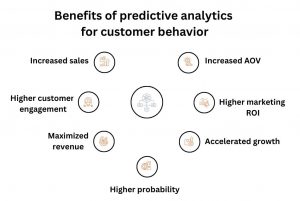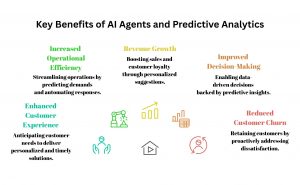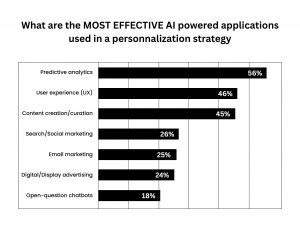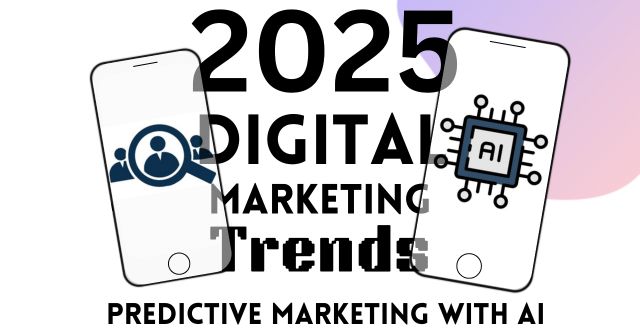What if you could know exactly what your customer wants before they even ask? In 2025, that question is no longer hypothetical, it’s the new reality of digital marketing.
Powered by artificial intelligence, predictive marketing is transforming how brands connect with their audiences by anticipating behavior instead of reacting to it. This shift allows marketers to craft personalized, timely experiences that don’t just meet expectations, they exceed them.
In this blog, we’ll explore how AI driven predictive marketing is redefining engagement, loyalty, and growth in the digital age.
“In the age of AI, the best marketers don’t follow trends—they predict them.”
This quote captures the essence of predictive marketing: staying ahead of customer needs by leveraging artificial intelligence.
1. The Rise of Predictive Analytics in Marketing
AI-powered predictive analytics scrutinizes extensive datasets to uncover customer patterns, preferences, and purchasing signals. As the graph below illustrates, a significant majority of marketing leaders report that AI enhances their ability to anticipate customer actions, with improved forecasting accuracy being a primary benefit.
This data-driven clarity allows marketers to move beyond guesswork, enabling them to forecast customer behaviors such as cart abandonment or product preferences, and to time campaigns more effectively. The result is more personalized messaging and efficient budget allocation.

2. Hyper-Personalization Through Behavioral Prediction
Predictive marketing facilitates hyper-personalization, allowing brands to tailor content, offers, and touchpoints based on individual behaviors. According to the graph below, a substantial percentage of marketers utilizing AI report that it aids in delivering the right message at the right time across various channels.
This anticipatory approach enables AI to identify micro-moments where customers are most likely to engage, thereby increasing click-through rates and conversions. Examples include product recommendations based on recent browsing history or emails timed to align with buying intent.

3. Smarter Campaign Optimization and ROI
AI’s capabilities extend beyond predicting customer desires to optimizing marketers’ responses. Campaigns driven by predictive insights are adjusted automatically based on real-time performance data. The graph below indicates that a significant portion of brands employing AI experience higher ROI through enhanced audience segmentation and optimized spending.
This dynamic allocation of resources leads to more effective campaigns, reduced ad waste, and increased profitability.

4. Predicting Churn and Enhancing Customer Retention
Predictive marketing also plays a crucial role in customer retention. AI can detect early signs of churn by analyzing factors such as customer sentiment, usage frequency, and support interactions. As depicted in the graph below, a notable percentage of marketers utilize predictive models to identify at-risk customers and intervene proactively.
By implementing re-engagement emails, loyalty offers, or personalized support, brands can address potential issues before they escalate, proving to be more cost-effective than strategies focused solely on acquisition.

TOO LONG TO READ?
-
Enhanced forecasting helps marketers predict customer behavior with greater accuracy.
-
Hyper-personalization allows AI to deliver tailored messages at the right moment.
-
Optimized campaigns adjust in real-time, improving ROI and reducing waste.
-
Proactive retention enables brands to detect churn risks and act early to retain customers.
- The focus is on understanding the customers, and anticipating their needs before they arise and responding intelligently and ethically.
Interested? Check out similar blogs:
2025 Digital Marketing Trends: How AI Is Revolutionizing Customer Experience
2025 Digital Marketing Trends: How to Build Customer Journeys
2025 Digital Marketing Trends: Online Advertising – From Cookies to First-Party Data




Very insightful! I really liked how the blog breaks down predictive marketing and how AI is anticipating customer needs nowadays, it really a game changer. Keep it up!
Thank you so much for the comment, I’m glad you found the breakdown of predictive marketing clear and insightful. AI truly is transforming how businesses understand and meet customer needs. In your opinion, what industry do you think will benefit the most from predictive marketing?
I think the retail industry will benefit the most from predictive marketing. With AI’s ability to forecast trends and anticipate customer preferences, retailers can not only optimize inventory but also create targeted campaigns.
You’re right steve, retailers are definitely in a prime position to take advantage of predictive marketing
Bro I really liked your quote saying marketers don’t follow trends, they predict them. I guess the best marketers are moving from reactive to proactive strategies
Yeah with AI it’s not about reacting, it’s about predicting what’s next. Glad you caught that Bro haha